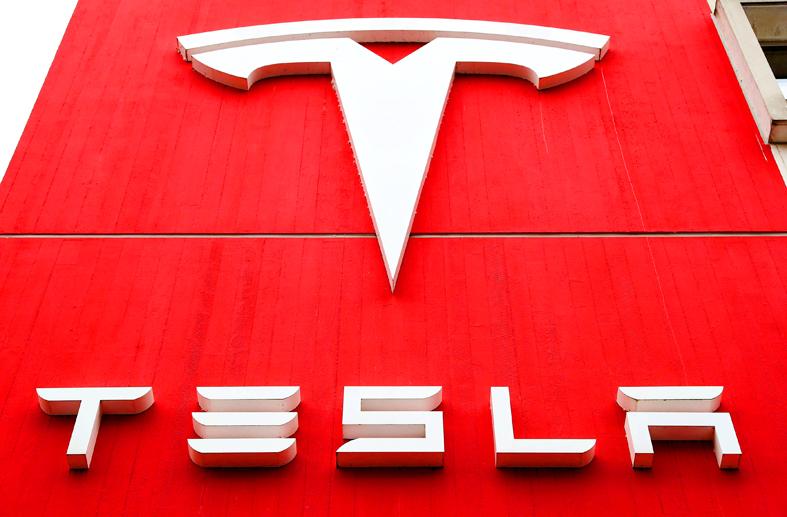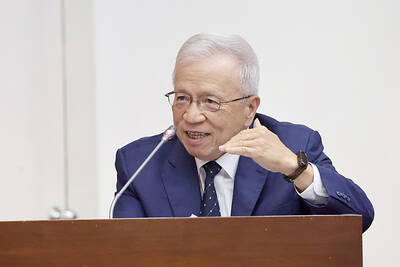Neoen SA yesterday said that it is to partner with Tesla Inc to install one of the world’s biggest lithium-ion batteries in Australia after reaching a grid connection deal with the power market operator.
The 300 megawatt Victorian Big Battery is planned for Geelong in Victoria state and use Tesla’s Megapack technology.
It would be double the size of Neoen’s Hornsdale site in South Australia state, which was the largest facility when it began operations in 2017.

Photo: Reuters
Installing the new system in Australia’s second-most populous state would help to modernize and stabilize the local grid, which is targeting 50 percent of its power to come from renewable sources by 2030, Neoen said in a media release.
The Paris-based company is targeting the battery to be operational by the end of next year.
Battery storage technology is being deployed on an ever-growing scale to meet demand to back-up the surge in wind and solar power generation.
About US$951 billion would be invested in the technology through 2050, with two-thirds deployed on utility-scale systems, BloombergNEF forecasts showed.
Tesla is seeing rising demand for grid-scale batteries and the new Australian project would offer further evidence that the systems are suitable to back up intermittent wind and solar power, Tesla chairwoman Robyn Denholm told a webinar.
“What we’re seeing is many energy operators around the world don’t want to renew their fossil fuel-type turbines, they want to put storage in, they want to harness renewable energy,” Denholm said.
Tesla founder Elon Musk has previously said that the firm’s energy business could one day rival its electric vehicle division in size.
Neoen’s Hornsdale lost its status as the world’s biggest storage battery to a facility near San Diego, California, which began operations this year. Several other larger battery projects are planned, including in the US and China, BloombergNEF data show.
“The big battery will help protect our network in summer, create jobs and drive down energy prices, as well as supporting our recovery from the coronavirus pandemic,” Victoria Minister for Energy, Environment and Climate Change Lily D’Ambrosio said in a separate statement.
The new project in Victoria would be supported by a 250 megawatt grid services contract with the Australian Energy Market Operator and would also partner with network provider AusNet Services, Neoen said.

JITTERS: Nexperia has a 20 percent market share for chips powering simpler features such as window controls, and changing supply chains could take years European carmakers are looking into ways to scratch components made with parts from China, spooked by deepening geopolitical spats playing out through chipmaker Nexperia BV and Beijing’s export controls on rare earths. To protect operations from trade ructions, several automakers are pushing major suppliers to find permanent alternatives to Chinese semiconductors, people familiar with the matter said. The industry is considering broader changes to its supply chain to adapt to shifting geopolitics, Europe’s main suppliers lobby CLEPA head Matthias Zink said. “We had some indications already — questions like: ‘How can you supply me without this dependency on China?’” Zink, who also

At least US$50 million for the freedom of an Emirati sheikh: That is the king’s ransom paid two weeks ago to militants linked to al-Qaeda who are pushing to topple the Malian government and impose Islamic law. Alongside a crippling fuel blockade, the Group for the Support of Islam and Muslims (JNIM) has made kidnapping wealthy foreigners for a ransom a pillar of its strategy of “economic jihad.” Its goal: Oust the junta, which has struggled to contain Mali’s decade-long insurgency since taking power following back-to-back coups in 2020 and 2021, by scaring away investors and paralyzing the west African country’s economy.

Taiwan Semiconductor Manufacturing Co (TSMC, 台積電) received about NT$147 billion (US$4.71 billion) in subsidies from the US, Japanese, German and Chinese governments over the past two years for its global expansion. Financial data compiled by the world’s largest contract chipmaker showed the company secured NT$4.77 billion in subsidies from the governments in the third quarter, bringing the total for the first three quarters of the year to about NT$71.9 billion. Along with the NT$75.16 billion in financial aid TSMC received last year, the chipmaker obtained NT$147 billion in subsidies in almost two years, the data showed. The subsidies received by its subsidiaries —

BUST FEARS: While a KMT legislator asked if an AI bubble could affect Taiwan, the DGBAS minister said the sector appears on track to continue growing The local property market has cooled down moderately following a series of credit control measures designed to contain speculation, the central bank said yesterday, while remaining tight-lipped about potential rule relaxations. Lawmakers in a meeting of the legislature’s Finance Committee voiced concerns to central bank officials that the credit control measures have adversely affected the government’s tax income and small and medium-sized property developers, with limited positive effects. Housing prices have been climbing since 2016, even when the central bank imposed its first set of control measures in 2020, Chinese Nationalist Party (KMT) Legislator Lo Ting-wei (羅廷瑋) said. “Since the second half of